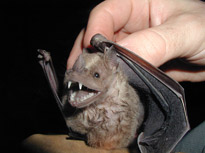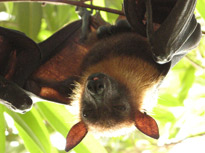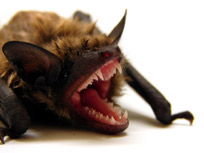Chiroptera -- Winged flying aces, equipped with Sonar



Origins
Chiroptera comes from two Greek words, cheir or "hand" and pteron "wing". This name really gets to the essence of this remarkable order whose fingers have membrane(thin film) around them, making wings that can be very dexterously used for flight. These are the only mammals that can truly fly as well as birds. Some of them even migrate like birds do, in search of food.
The most ancient fossil that was an ancestor of all the families of known bats is Icaronyteris index, and dates from 50 million years ago. It appears to be fairly modern, and it is thought that it could echolocate based on the size and shape of its inner ear. Scientist think that an ancestor further back in time, perhaps well before the dinosaurs went extinct, evolved to glide in the huge forest of the cretaceous era. Gradually, it evolved a membrane like the pterosaurs and began to actually fly.
What are they like?
The order has traditionally been divided into Microchiroptera(smaller,echo locating and insect-eating species) and Megachiroptera(fruit eating large bats). The smaller ones are almost exclusively insect eaters and the Megachiroptera are almost overwhelmingly vegetarian. So, the stories about giant blood-sucking bats are just a bunch of baloney.
The most amazing feature about microchiroptera is that they rely on echolocation to find their prey and map their surroundings. They are among very few creatures who can do this very well. Bats do not see very well but some species can detect ultra-violet light(we humans can't see that).
Bat wings are quite special. They are thinner than birds and so help the bat maneuver better. The bones in a bats fingers are almost the flexibility of cartilage so it does not splinter due to the pressures of flight. If the wing membrane does tear, it can quickly heal itself. The membrane has amazing touch-sensitive cells on it(very like the human finger) that help the bat detect the changes in air flow around the wings. Even Batman cannot really do better than that!
Geographic Distribution
View Larger Map
Reproduction
Most bats have a breeding season, which is in the spring for species living in a temperate climate. Bats may have one to three litters in a season, depending on the species and on environmental conditions such as the availability of food and roost sites. Females generally have one offspring at a time. Female bats nurse their youngster until it has grown nearly to adult size as a young bat cannot look for food on its own until its wings are properly developed.
Feeding Habits
Most Microchiropterans feed on insects and hunt for them using echolocation. Some bats can hear insect on the forest floor and they can typically fly down and grasp their prey off the ground with their teeth. Some species have adapted to life as fruit or nectar eaters and are responsible for pollinating at least 150 different types of fruits and flowering plants. The interesting ones like vampire bats are carnivores and drink blood. They actually don't suck blood, they make a precise surgical cut near a blood vessel( near the ear or the legs, mostly) and then slurp away at the wound.
Families within chiroptera
Craseonycteridae(Hog-Nosed Bats)
Mystacinidae(NZ Short-tailed Bats)
Pteropodidae(Flying Foxes)
Rhinopomatidae(Mouse-tailed Bats)
Emballonuridae(Sheath-tailed Bats)
Nycteridae(Slit-faced Bats)
Megadermatidae(False Vampires)
Rhinolophidae(Horseshoe Bats)
Hipposideridae(OW Leaf-nosed Bats)
Noctilionidae(Bulldog Bats)
Mormoopidae(Spectacled Bats)
Phyllostomidae(NW Leaf-nosed Bats)
Natalidae(Funnel-eared Bats)
Furipteridae(Thumb-less Bats)
Thyropteridae(Disk-winged Bats)
Myzopodidae(Sucker-footed Bats)
Vespertilionidae(Vesper Bats)
Molossidae(Free-tailed Bats)
Videos
Mystacinidae(NZ Short-tailed Bats)
Pteropodidae(Flying Foxes)
Rhinopomatidae(Mouse-tailed Bats)
Emballonuridae(Sheath-tailed Bats)
Nycteridae(Slit-faced Bats)
Megadermatidae(False Vampires)
Rhinolophidae(Horseshoe Bats)
Hipposideridae(OW Leaf-nosed Bats)
Noctilionidae(Bulldog Bats)
Mormoopidae(Spectacled Bats)
Phyllostomidae(NW Leaf-nosed Bats)
Natalidae(Funnel-eared Bats)
Furipteridae(Thumb-less Bats)
Thyropteridae(Disk-winged Bats)
Myzopodidae(Sucker-footed Bats)
Vespertilionidae(Vesper Bats)
Molossidae(Free-tailed Bats)
Videos
Pteropodidae(Flying Foxes)
Rhinopomatidae(Mouse-tailed Bats)
Emballonuridae(Sheath-tailed Bats)
Nycteridae(Slit-faced Bats)
Megadermatidae(False Vampires)
Rhinolophidae(Horseshoe Bats)
Hipposideridae(OW Leaf-nosed Bats)
Noctilionidae(Bulldog Bats)
Mormoopidae(Spectacled Bats)
Phyllostomidae(NW Leaf-nosed Bats)
Natalidae(Funnel-eared Bats)
Furipteridae(Thumb-less Bats)
Thyropteridae(Disk-winged Bats)
Myzopodidae(Sucker-footed Bats)
Vespertilionidae(Vesper Bats)
Molossidae(Free-tailed Bats)
Videos